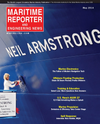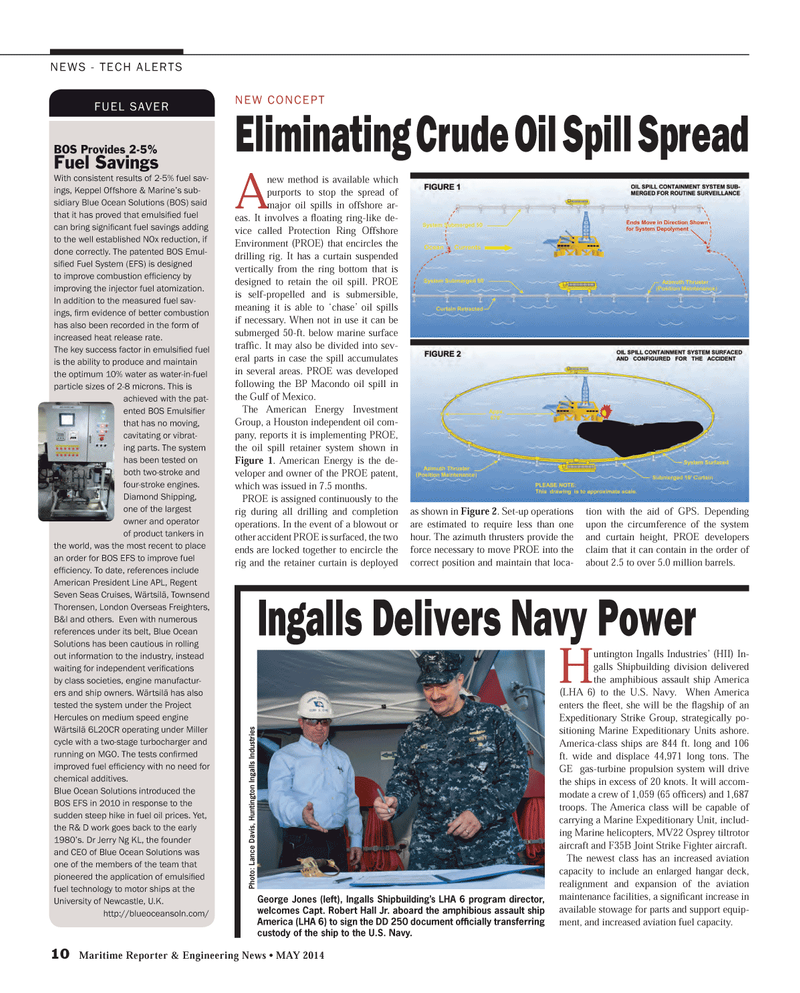
Page 10: of Maritime Reporter Magazine (May 2014)
Marine Electronics Edition
Read this page in Pdf, Flash or Html5 edition of May 2014 Maritime Reporter Magazine
10 Maritime Reporter & Engineering News • MAY 2014
NEWS - TECH ALERTS
BOS Provides 2-5%
Fuel Savings
With consistent results of 2-5% fuel sav- ings, Keppel Offshore & Marine’s sub- sidiary Blue Ocean Solutions (BOS) said that it has proved that emulsifi ed fuel can bring signifi cant fuel savings adding to the well established NOx reduction, if done correctly. The patented BOS Emul- sifi ed Fuel System (EFS) is designed to improve combustion effi ciency by improving the injector fuel atomization.
In addition to the measured fuel sav- ings, fi rm evidence of better combustion has also been recorded in the form of increased heat release rate.
The key success factor in emulsifi ed fuel is the ability to produce and maintain the optimum 10% water as water-in-fuel particle sizes of 2-8 microns. This is achieved with the pat- ented BOS Emulsifi er that has no moving, cavitating or vibrat- ing parts. The system has been tested on both two-stroke and four-stroke engines.
Diamond Shipping, one of the largest owner and operator of product tankers in the world, was the most recent to place an order for BOS EFS to improve fuel effi ciency. To date, references include
American President Line APL, Regent
Seven Seas Cruises, Wärtsilä, Townsend
Thorensen, London Overseas Freighters,
B&I and others. Even with numerous references under its belt, Blue Ocean
Solutions has been cautious in rolling out information to the industry, instead waiting for independent verifi cations by class societies, engine manufactur- ers and ship owners. Wärtsilä has also tested the system under the Project
Hercules on medium speed engine
Wärtsilä 6L20CR operating under Miller cycle with a two-stage turbocharger and running on MGO. The tests confi rmed improved fuel effi ciency with no need for chemical additives.
Blue Ocean Solutions introduced the
BOS EFS in 2010 in response to the sudden steep hike in fuel oil prices. Yet, the R& D work goes back to the early 1980’s. Dr Jerry Ng KL, the founder and CEO of Blue Ocean Solutions was one of the members of the team that pioneered the application of emulsifi ed fuel technology to motor ships at the
University of Newcastle, U.K. http://blueoceansoln.com/
FUEL SAVER
A new method is available which purports to stop the spread of major oil spills in offshore ar- eas. It involves a fl oating ring-like de- vice called Protection Ring Offshore
Environment (PROE) that encircles the drilling rig. It has a curtain suspended vertically from the ring bottom that is designed to retain the oil spill. PROE is self-propelled and is submersible, meaning it is able to ‘chase’ oil spills if necessary. When not in use it can be submerged 50-ft. below marine surface traffi c. It may also be divided into sev- eral parts in case the spill accumulates in several areas. PROE was developed following the BP Macondo oil spill in the Gulf of Mexico.
The American Energy Investment
Group, a Houston independent oil com- pany, reports it is implementing PROE, the oil spill retainer system shown in
Figure 1. American Energy is the de- veloper and owner of the PROE patent, which was issued in 7.5 months.
PROE is assigned continuously to the rig during all drilling and completion operations. In the event of a blowout or other accident PROE is surfaced, the two ends are locked together to encircle the rig and the retainer curtain is deployed as shown in Figure 2. Set-up operations are estimated to require less than one hour. The azimuth thrusters provide the force necessary to move PROE into the correct position and maintain that loca- tion with the aid of GPS. Depending upon the circumference of the system and curtain height, PROE developers claim that it can contain in the order of about 2.5 to over 5.0 million barrels.
Eliminating Crude Oil Spill Spread
NEW CONCEPT
H untington Ingalls Industries’ (HII) In- galls Shipbuilding division delivered the amphibious assault ship America (LHA 6) to the U.S. Navy. When America enters the fl eet, she will be the fl agship of an
Expeditionary Strike Group, strategically po- sitioning Marine Expeditionary Units ashore.
America-class ships are 844 ft. long and 106 ft. wide and displace 44,971 long tons. The
GE gas-turbine propulsion system will drive the ships in excess of 20 knots. It will accom- modate a crew of 1,059 (65 offi cers) and 1,687 troops. The America class will be capable of carrying a Marine Expeditionary Unit, includ- ing Marine helicopters, MV22 Osprey tiltrotor aircraft and F35B Joint Strike Fighter aircraft.
The newest class has an increased aviation capacity to include an enlarged hangar deck, realignment and expansion of the aviation maintenance facilities, a signifi cant increase in available stowage for parts and support equip- ment, and increased aviation fuel capacity.
Ingalls Delivers Navy Power
George Jones (left), Ingalls Shipbuilding’s LHA 6 program director, welcomes Capt. Robert Hall Jr. aboard the amphibious assault ship
America (LHA 6) to sign the DD 250 document offi cially transferring custody of the ship to the U.S. Navy.
Photo: Lance Davis, Huntington Ingalls Industries
MR #5 (10-17).indd 10 5/1/2014 10:17:52 AM

 9
9

 11
11
